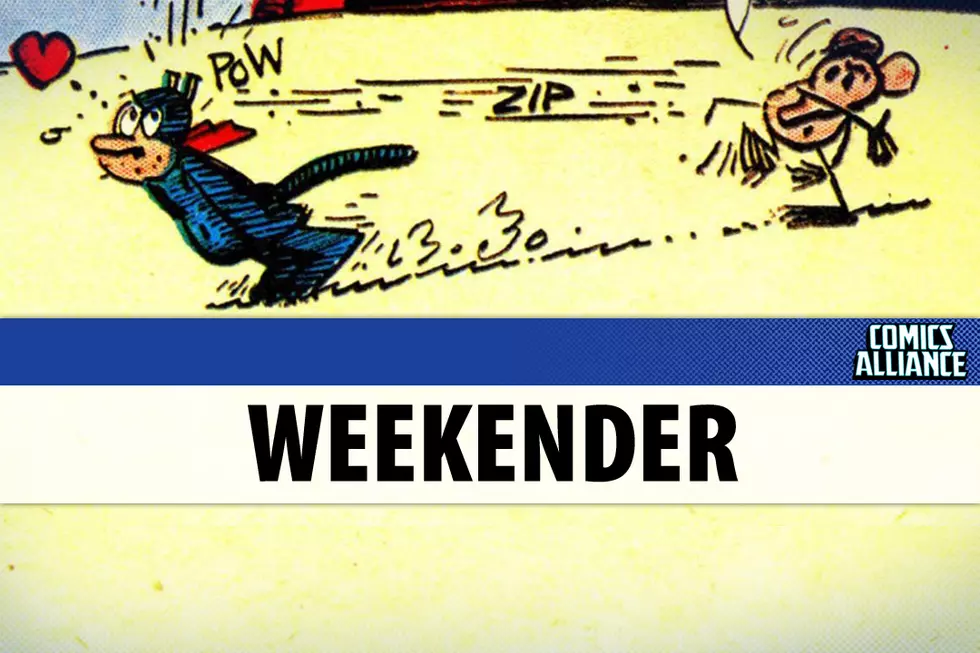
DIY Roundup: Five Great Mini-Comics From the Fluke Festival

This weekend, I drove down to Athens, Georgia for Fluke, a one-day mini-comics festival held at the 40 Watt. It was my second time setting up there, and it's a great show that presents the perfect opportunity to meet the independent creators who are often overlooked in favor of mainstream writers and artists at bigger conventions, and check out what they have to offer.
That's exactly what I did, and while I wasn't able to pick up every comic I wanted, the stuff that I did get turned out to be pretty fantastic. Check out a few highlights from the world of DIY comics from this year's Fluke! The first thing that I made sure to pick up at the show was Gruff, a new series of mini-comics by Jason Horn:

I've been a fan of Horn's for a while, ever since I met him at a convention and picked up a mini of Ninjasaur, a comic he's since moved to the web. As you might expect from the title, Ninjasaur is a mashup comic in the classic vein, telling the story of a world-weary stegosaurus who is also a ninja. It's about one Batman away from being my platonic ideal of a comic book, and Horn does a great job making the high concept adventures enjoyable, especially in the new print version that he was able to fund through Kickstarter.
Gruff is something different. What originally attracted me to it, aside from the fact that I was a fan of Horn's work to begin with, is that it was one of the best-looking books at the show. He went all out in the mini, with a full-color cardstock cover and parchment-patterned interior pages rather than the standard white. There was even a companion piece, a map rolled into a scroll and bound with cornsilk, and the only thing at Fluke that even came close was a Dracula comic involving vellum interiors and a glow-in-the-dark stamped cover that I unfortunately didn't get the chance to snag. It's a good-looking production, and it stands out.
But all the fancy stationery in the world won't make a bad comic good, and the content is what really shines. The only real flaw in Gruff is that it's slow-paced at the start, but that just helps to set things up. The story is a sequel of sorts to the fairy tale of the Three Billy Goats Gruff, focused on a gruff (ha ha) goat forming a friendship with a meek but friendly turtle named Meeks. In case the fact that he does a book called Ninjasaur wasn't a big enough tipoff, those names should be a pretty big clue that Horn isn't all that big on subtlety.
Anyway, the first issue is entirely devoted to Gruff and Meeks taking a walk through the woods on their way to get muffins, but just when you think you have a handle on what seems to be a simple children's story about friendship overcoming differences, the stuff gets real.

The comic suddenly shifts into a fantasy epic, full of secret societies and looming threats from the owl that rules over the forest, and a mystery surrounding the murder of Meeks' parents. Like I said, it's a slow burn, but when that hits, you're already hooked. I'm sure Horn has heard people comparing what he's doing here to Bone -- especially with his similar style to Jeff Smith's -- but that's not exactly bad company to be in with a story like this.
Gruff is pretty expensive as far as mini-comics go -- there are five individual chapters at five bucks each -- but the nice thing about a mini-comics festival is that you know your money's going straight to the people who wrote, drew, designed and, in a lot of cases, even stapled the comics themselves. And on that front, Gruff's definitely worth supporting. You can find out a little more about it here.
Another book that I made sure to grab was Beasts & Babes, a pin-up book by Erin Gladstone, Jackie Lewis and Cara McGee:

They're three SCAD graduates that I met through a mutual friend at last year's show, where I picked up Lewis's incredible BC/CC, a flip book of super-hero and heroine pin-ups oversexualized to a truly hilarious degree, complete with dialogue, and Sad Baby Monsters, a series of pin-ups that I featured here at CA.
In the new book, those two specialties come together pretty well, as each artist offers up four black-and-white pin-ups of barbarian ladies with what I believe the Dungeon Master's Guide classifies as "Unusual Mounts." There's a llama, a giant chicken and a snail of truly horrifying proportions, but my favorite was Gladstone's adorable polar bear:

Gladstone also had copies of Cute Little Love Story, a comic written by Jessi Reid (the mutual friend I mentioned earlier) that lives up to its name. It's a simple tale of romance told with no dialogue, and Gladstone's expressive art sells it perfectly. If you can't make it to a convention, you can check it out here and see for yourself.
As for Cara McGee, she had copies of a small book she'd done called How To Make a Decent Cuppa Tea that did exactly what it said on the cover. The instructions were illustrated with pretty awesome pots and kettles with happy faces drawn on them, and seriously: If you are looking for an excuse to use terms like "sheepish microwave" and "orgasmic teapot" to describe something you just saw -- and I can't imagine you're not -- it is the comic to check out.
Rounding out the list of people in attendance that I actually knew was Catie Donnelly, whose new mini was called Whippin' Sh***ies:

Catie actually had two books at the show. The other was I Know You're Mad, about dealing with depression, and while it's very well done, Whippin' Sh***ies was the one I was all in for. The genesis of it was Catie learning of the Midwestern term for what the rest of us refer to as "doing donuts," and the sheer, unbridled hilarity she found in this fact. It is like joy crystallized onto the paper, and there's a version with an extra page you can download from her website. And just in case we're not clear at this point, there is NSFW language involved.
I also picked up Max Young's Jetpack Shark, for what are probably obvious reasons:

Really, though, as much as I subscribe to the theory that combining two awesome things usually gives you one super-awesome thing, a high concept just gets a book an initial look. If it's not actually good, there's no magic combination of carnivorous animals and action figure accessories that's going to save it.
Fortunately, Young does a bang-up job with making his book entertaining. It's insanely violent with a strong helping of sexual content thrown in, with every single aspect of it taken to the ridiculous extreme promised by the title, but Young plays it entirely straight, which only makes it funnier. It's a late night HBO action movie from 1996 -- complete with mermaid strippers with butterfly tattoos on their lower backs, which I find inexplicably hilarious -- nudged just over the line into parody. There's really only one time in the book where Young actually acknowledges that he's making a joke, when the Nazi scientist who created Jetpack Shark's dialogue is footnoted with "Translated From Crazy Nazi." It's a hoot.
My absolute favorite mini-comics from the show, though, were five issues of Emi Gennis's Spaz:

If you've ever read mini-comics at all, then the format that Gennis is working with here is pretty familiar: Short autobiographical stories inspired by everything from relationships to true stories culled from her job at a restaurant in Chicago to nagging fears and anxieties that she deals with on a daily basis. They're all well-done, with a gift for comic timing and reactions that puts them a cut above the usual crop of minis, but what really pushes Spaz to the next level is a recurring series she starts in #3, based on the Wikipedia List of Unusual Deaths:

Hearing Gennis describe these was what sold me on picking up all five issues of the comic, and they're seriously fantastic, and I wish I hadn't lost the one full-length story she'd done along these lines after I bought it. It might seem morbid -- and to be honest, I guess it actually is morbid -- but the detached Wikipedia-like tone combined with Gennis's expressive art is a fascinating and engaging way to present what are already pretty interesting stories, especially in the context of someone's thoughts and memories.
When you pick up a bunch of someone's mini-comics at once, it's really interesting to see how their style has changed over the years, and Spaz is no exception. The first issue was printed in 2009, and #5 in 2011, so you can see Gennis refining her techniques and getting better as a storyteller as she goes.
It's also worth noting that the fifth issue is far and away the darkest, opening with one of the most recent and tragic Unusual Deaths, moving on to a not-so-cheery exploration of Munchausen's Syndrome By Proxy, then moving into a memory of going to school with a kid who murdered his own father, and then adds in an illustrated list of roller coaster accidents (yes, really) on the off chance that things weren't quite dark enough. But it's also hands down the best, with story and art that are leaps and bounds ahead of what she was doing in her previous comics, which were already pretty good to begin with. There's a shift in style that's just incredible to see play out over the issues, and the result is something I have no qualms about calling a genuinely great comic.
If you see her at a convention, it's well worth your time and money to check them out, and you can pick them up at her website if you can't wait.
And really, that's the great thing about Fluke, and conventions in general. As much as I don't think of myself as a guy who particularly likes autobio comics or minis, I love to try something new and see what it's all about, and getting to talk to people and have them tell you about their comics is something that's just intrinsically fun. I just wish I could've picked up more.
More From ComicsAlliance


![Heading ‘Over The Garden Wall’ With Jim Campbell [Interview]](http://townsquare.media/site/622/files/2016/04/otgw-feat.jpg?w=980&q=75)





![Jurassic Meets Assassins in Jason Horn’s ‘Ninjasaur’ [Back Pages]](http://townsquare.media/site/622/files/2015/03/ninjasaur-feat.jpg?w=980&q=75)
